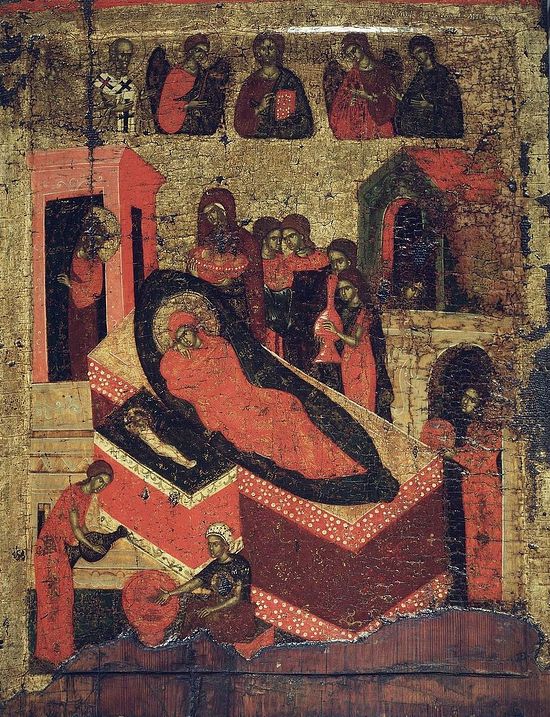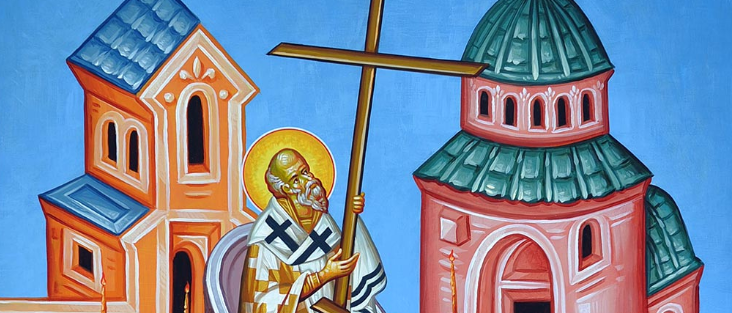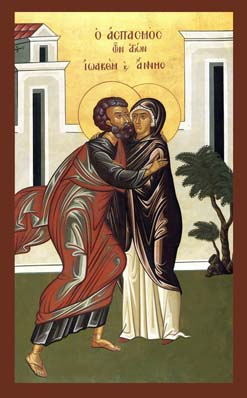 How common it is for us to celebrate the birth and milestones in the life of our friends and those whom we hold dear. We enjoy celebrating their birthday and achievements expressing our camaraderie in their triumphs along their life’s journey, rejoicing when they rejoice. Is this not even more natural for us to do within the Church? There are many saints whom we are drawn to (or, more correctly, they draw us to themselves) and we, therefore, make a point to be aware of the day that their feast is celebrated, take time out to read their life and works, prepare and commune at the Divine Liturgy and honour them recognizing their place in the wider Church as well as in our own lives. Therefore, today is no different, and yet it is, due to the greatness of the one we are celebrating: Mary, the Mother of God.
How common it is for us to celebrate the birth and milestones in the life of our friends and those whom we hold dear. We enjoy celebrating their birthday and achievements expressing our camaraderie in their triumphs along their life’s journey, rejoicing when they rejoice. Is this not even more natural for us to do within the Church? There are many saints whom we are drawn to (or, more correctly, they draw us to themselves) and we, therefore, make a point to be aware of the day that their feast is celebrated, take time out to read their life and works, prepare and commune at the Divine Liturgy and honour them recognizing their place in the wider Church as well as in our own lives. Therefore, today is no different, and yet it is, due to the greatness of the one we are celebrating: Mary, the Mother of God.
Life & Faith
Exaltation of the Holy Cross
 The Feast of the Universal Exaltation of the Precious and Life-Giving Cross is celebrated each year on September 14. The Feast commemorates the finding of the True Cross of our Lord and Savior Jesus Christ by Saint Helen, the mother of the Emperor Constantine.
The Feast of the Universal Exaltation of the Precious and Life-Giving Cross is celebrated each year on September 14. The Feast commemorates the finding of the True Cross of our Lord and Savior Jesus Christ by Saint Helen, the mother of the Emperor Constantine.
In the twentieth year of his reign (326), the Emperor Constantine sent his mother Saint Helen to Jerusalem to venerate the holy places and to find the site of the Holy Sepulchre and of the Cross. Relying upon the oral tradition of the faithful, Saint Helen found the precious Cross together with the crosses of the two thieves crucified with our Lord. However, Helen had no way of determining which was the Cross of Christ.
Sermon for the Nativity of the Theotokos
Sts Joachim and Anna, parents of Blessed Mary (Theotokos)
 So much attention is paid by Christians to the Blessed Virgin Mary, the Theotokos, sanctified in every conceivable way, that there is a tendency to overlook her parents. Commemorated the day after the commemoration of their daughter, who is remembered on other days as well, Joachim and Anna were the parents of a flesh-and-blood human being they called Mary and, therefore, the grandparents of a flesh-and-blood human being, in form at least, who died to save the world.
So much attention is paid by Christians to the Blessed Virgin Mary, the Theotokos, sanctified in every conceivable way, that there is a tendency to overlook her parents. Commemorated the day after the commemoration of their daughter, who is remembered on other days as well, Joachim and Anna were the parents of a flesh-and-blood human being they called Mary and, therefore, the grandparents of a flesh-and-blood human being, in form at least, who died to save the world.
Considered in this light, this couple is appreciated most by the grandfathers and grandmothers of the world.
The spiritual beauty of St Anna is expressed in the Bible, equalled by that of her devoted husband, the too lightly regarded Joachim. Since there is no greater part of the divine plan of the universe than motherhood, it follows that St. Anna is given individual honour with an observance of a feast day in her name on July 26. This in no way diminishes the image of her husband St Joachim.
Nativity of the Theotokos
 Commemorated September 8
Commemorated September 8
The establishment of four major feast days to honour the Blessed Virgin Mary took place in the days of the apostolic era and have a significance in the Greek Orthodox Church which has remained unaltered through nearly twenty centuries of Christianity. The mother' of the Son of God is honoured on March 25, the day of Annunciation when the Archangel Gabriel told Mary she was to become the mother of Jesus Christ; the Repose of the blessed Virgin Mary on August 15; on November 21, the Entrance of the Blessed Theotokos to the Temple; and on February 2 when the Mother of God brought the infant Jesus to the temple for presentation forty days after His birth.
A fifth day of commemoration is celebrated on September 8, honouring the Virgin Mary on the day of her birth. This day was set aside by the Orthodox Church in the early first century, but not observed until the eighth century when Pope Sergios saw fit to join with the Orthodox during his reign which extended from A.D. 687 to 701. All of Christendom agreed on the date that the Virgin Mary was born, but for some reason the date was not an official feast day in the Roman sector for more than a third of the length of existence of the Christian Church.
The familiar story of Mary's birth has had variations in splinter groups of Christianity, but there is no doubt that her birth came about as an act of God. Her parents, Joachim and Anna, were childless and were fast approaching the years which would place Anna beyond the age of childbearing. Perhaps it was because of the intensity of their prayers that a child be born to them that their prayers were not only answered, but their child would, in turn, bear a child ordained by God as his Son. No one who calls himself a Christian can accept the virgin birth as anything but an act of God.
Although Mary is known as the mother of God, she has been accorded numerous titles in the Orthodox Church of which few are aware. They include, in addition to Mary, Mother of God: The Repose (Koimesis) of the Blessed Virgin, Mary Pantanissa, Mary of Tinos, Mary of Malcheon, and Mary Vlacherne (just to mention a few of the many honours applied to her name). Considered the Mother of Mothers and the Mother of all Mankind, she is venerated in a manner which helps to sanctify the role of motherhood and the preservation of the family as the only hope for civilisation. In an age of equal rights, the God-given right to motherhood, which is the mainstay of Christianity, is lost in a cloud of other 'rights' that have no meaning in the presence of God. Those who clamour for those 'rights' are not aware that there is no inferiority in women, proof of which is an approach to God and a reading of the Bible as a stronger document than any constitution. It is regrettable that the immaculate conception, not to be confused with the virginal birth of the Saviour, is a concept of the Mother of God which the Roman Church assumed in 1854 and with which the Orthodox Church is in total disagreement. This concept holds that Mary was born without the stain of original sin brought upon all mankind by Adam and Eve. But the Orthodox position holds that since Jesus Christ is God, he is, therefore the only one who is without the original stain. The point could be argued endlessly; but in spite of dogmatic differences, there is no lessening in the adoration of Mary as the Mother of God. There can be no doubt that she was made pure on the day of the Annunciation when told by Gabriel she was going to be the Virgin Mother of the Messiah. The Orthodox position stems from the concept that if the immaculate conception is taken literally, then Mary would assume the stature of goddess alongside God. The popularity of the name of Mary attests to the glorification of the Virgin Mary. The Greek Orthodox can feel exultation from calling out the name "Panagia" which means 'All-Holy' and is the Greek word for the most sacred figure in Christianity, aside from the Son she mothered.
The Commemoration of the Miracles of the Holy Archangel Michael
September 19 / September 6
Near Hierapolis, in Phrygia, there was a place called Chonae (“plung- ing”), and in that place there was a spring of miraculous water. When Apostle John the Theologian, accompanied by Philip, preached the Gospel in Hierapolis, he looked upon that place and prophesied that a spring of miraculous water would open up there, from which many would receive healing, and that the great Archangel of God Michael would visit that place. Soon afterward, this prophecy was fulfilled: a spring of water burst forth and became widely known for its miraculous power. A pagan in Laodicea had a daughter who was mute, which caused him great sorrow. Archangel Michael appeared to him in a dream, and told him to take his daughter to the spring, where she would be cured. The father immediately obeyed, brought his daughter to the spring, and found many people there seeking deliverance from various infirmities. These people were all Christians. The man asked how he should seek healing, and the Christians told him: “You must pray to the Archangel Michael, in the name of the Father and of the Son and of the Holy Spirit.” The man prayed in this way, gave his daughter a drink of this water, and the girl began to speak. The pagan, his daughter and his whole household were baptized. He also built a church over the spring dedicated to the Archangel Michael.
Later, a young man named Archippus settled there and lived a life of austerity, in fasting and prayer. The pagans did many malicious things to Archippus, for they did not like the fact that this Christian holy place emanated such spiritual power and attracted so many people to it. The pagans, in their wickedness, rerouted the nearest river in order to flood the church and the spring. By the prayers of Archippus, the holy Archangel Michael opened a fissure in the rock beside the church, and the river’s water plunged into it. This is how that place was saved and why it was called Chonae, or “of the plunging,” for the river’s water that plunged into the open fissure. St. Archippus labored in asceticism there until the age of seventy, and peacefully reposed in the Lord.
Petar (Zimonjic) of Dabar-Bosna
Our father among the saints, Hieromartyr Metropolitan Petar (Zimonjic) of Dabar-Bosna (Свети Свештеномученик Петар Дабробосански) was the Metropolitan of the diocese of Dabar-Bosnia in the Kingdom of Yugoslavia for twenty years until early in World War II. He was martyred during the Nazi occupation of Yugoslavia.
The future metropolitan Petar was the son of a nobleman ("vojvoda") and priest Bogdan Zimonjic (Богдан Зимоњић). He was born in Grahovo, on June 24, 1866. He attended the Theological Seminary in Reljevo between 1883 and 1887 and continued his education at the Orthodox Theological Faculty in Cernovice (today Ukraine) from 1887 until his graduation in 1893. In October 1893, Petar was appointed assistant professor at the Reljevo Theological Seminary, and a year later he was appointed professor.

